
Between the crazy workload for Fall Quarter, being out of town for conferences, and a bout with the Martian Death Flu, I confess to having fallen completely off the CCK08 and CCK08SL bandwagon. I didn’t just fall off, I think it ran me over on its way out of town. =)
Today is the first day in I can’t recall how long that I’ve had a moment to just sit down and think about CCK08 – and how woefully sad I am that I’ve ended up missing most of it. The first few weeks were a little overwhelming, but also very exciting, and the conversations we had at the synchronous meetings in Second Life were some of the best.. deep thinking I think I’ve ever truly done about “education” as a knowledge domain – what does it mean to “learn” something? What ways do we “learn”? How do we know when something is “known”? How do we “learn” best? Through the materials and readings in the course, the discussions and videos and podcasts, and the dialogue with colleagues and facilitators, I really enjoyed the experience.
Then life got in the way and the CCK08 bandwagon rolled on without me.
But it didn’t leave before leaving me with lots of interesting concepts, thoughts, conversations, and resources to think about and revisit. In spare moments making the rounds to check for litter in the Connectivism Village in Chilbo, I’ve stopped into the reading room and clicked the little TV screens or radios to listen to a recording of a session I didn’t get to attend. Or when triaging my ever-overflowing email, I take a second to scan The Daily newsletter to get a sense of what the wagon is talking about now.
And thinking about it, I really.. appreciate and admire the work and effort that has gone into this experiment. Even when my life is so truly busy that I don’t know which end is up, I am still “connected”. The technology implemented purposefully, in addition to the technology used and resources created ad hoc by the various participants, really enables you to “hook in” to this network in a multitude of different ways so that even when you aren’t paying attention – the currency of the web – you still are connected to these people, media, places, conversations, and readings. You have access to subject matter experts, a cohort to discuss and work with, and wide-ranging library of resources created by not just the instructors, but the participants themselves. You have peer review and feedback built into the system – every single time I contributed to CCK08 in any way, I _always_ got a response from another person – someone friending me back, or following me on Twitter, or leaving a comment on my blog, or responding to an email or question. I certainly did a lot of _CONNECTING_ when taking this class.
But I’ve been thinking it’s a real shame that I had such a hard time managing all of my other responsibilities and couldn’t fully participate, because it seems like under normal circumstances, this would be an almost perfect learning environment for me. When I did have the time, I wasn’t just “engaged” in that clinical sense (the “engagement” buzzword is starting to wear on me), I was really _into it_. It felt like learning, but it was _fun_. It was interesting, and thought provoking, and though I don’t know how much I “learned” if I had to take some standardized test about the course material, I can tell you I learned a heck of a lot.
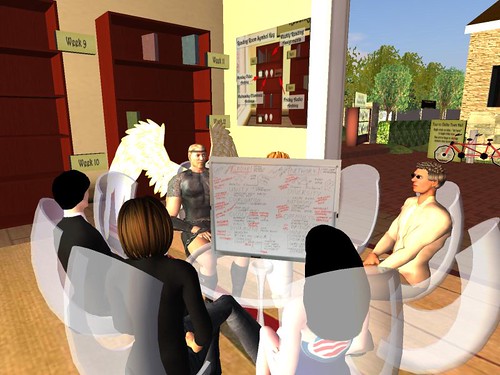
And in realizing that 1) I’m still connected to the people I formed bonds with in the beginning of the course (I’m imagining the lines between the boxes on my social network graph, and realizing that it wouldn’t work to model those lines with, say, thickness as an indicator of the strength of the bond, because in reality, the bond is mutable – at times I have weaker ties with nodes in my network, and when they become relevant, or needed, or reach out to me in some say, those ties become stronger – so the “lines” should be modeled more like energy flowing, with ebbs and tides), 2) I still have access to all of the archives, media, and readings from the course, and 3) I actually learned a tremendous amount of skills, information, concepts, technical tools, and other people in an extremely short period of time…
I’ve come to the conclusion that I’m not so ashamed to have fallen off the wagon, after all, because the metaphor of the wagon is all wrong.
It’s really puzzling to take a course about the course, that is to say, learning about connectivism and connective knowledge by putting into practice the theory of connectivism and connective knowledge. I can’t separate out in my mind which of my .. reactions, for want of a better word, are related to the course material – the theory – and which are related to the experience of taking the course – the implementation. I think for the moment I’ve given up worrying about it. In the end, I realized that I’d been thinking of this “course” as a “course”. And when I could no longer participate in the “class”, then it felt as if I’d dropped out, and the group traveled on without me. But I think what this class taught me most of all, is that my concept of what makes a “course” completely clouded my thinking about the experience. I don’t think I failed the course, nor do I think the course failed me. This was a voluntary effort, and when I had the spare brain cycles to attend to it, I learned one heckuva lot.
So now, all these weeks later, I’m finally getting around to writing my first paper about/for the course, even if the synchronous component of it is nearly over. And I hope that all the plethora of resources that people created will remain for as long as they can, so if others fell off the wagon, or want to refer back to them as they continue on with their learning, they will be available to everyone who comes after. I thank @arieliondotcom for bringing this to my attention.
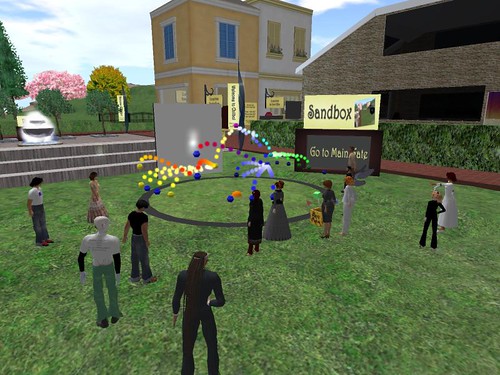
I did fail, however, in fulfilling my role as a _facilitator_ of the Second Life cohort, and I DO feel guilty about that. I apologize to all those who showed an interest in exploring how learning about Connectivism might be enhanced by using a virtual world. I did my best to provide the space, the tools, the initiative, the original organizing force to help make it happen, but I didn’t have the time to really _facilitate_ its use. I’m not sure what – other than time and personal attention – I could have done to improve making the tools available to whoever wanted to participate. If anyone has suggestions, I’m all ears. Here is what I did try:
– I created a web form so that anyone with an interest in exploring the SL cohort could sign up
– I created a central information page about the SL cohort, on a wiki, that anyone who requested access got it, and included a few frame work pages to store transcripts, a place to plan activities, and a space to share cohort members’ web links (blogs, twitter, whatever) so we could connect with each other outside of SL.
– I created a CCK08SL Googlegroup and added everyone who signed up on the webform, so we could communicate asynchronously via email with each other
– I created a space in Second Life, with informational rooms linking back out to web resources (to provide a visual component to digital resources), offered anyone new to Second Life a personal home/office space, offered kiosk space for experienced SL participants to share their other work/projects in SL with members of the cohort, and left as large a blank canvass sandbox space for people to play with building/creation as much room as Chilbo could afford to provide (land costs money there too!). I tried to add some “fun” or “interactive” elements like an automated bike tour and visually pleasing spaces to make the SL component as attractive and functional as I could.
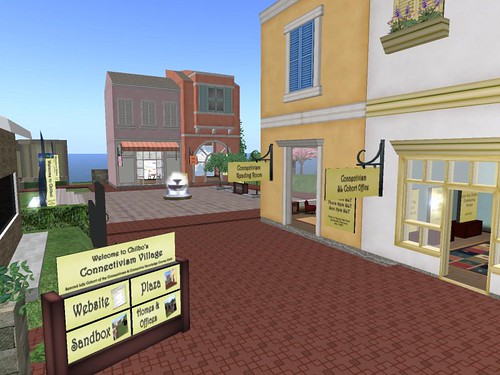
Here are some stats on the results, as of November 20, 2008:
– 133 people initially signed up for the Second Life cohort on the web form.
– 94 of those people responded to the very first email inviting them to join the SL Cohort Googlegroup (email list)
– 46 people responded to an email and expressed a time preference for synchronous meetings on Doodle
– There were 72 messages posted to the email list (only members could post, 69 web views of the discussion (anyone/public could view)
– 16 people responded to the invitation to create an account on the wiki to edit it, and 4 people took the time to make any edits (highest rate of participation was those who responded in email or added their blog to the wiki:
SL Cohort Blogs
* BarDil Joyce: Dilip Barad’s Weblog http://dilipbarad.blogspot.com
* Claude Desmoulins An Education and Technology Blog http://connecteded.wordpress.com
* Fleep Tuque: Fleep’s Deep Thoughts – http://fleeptuque.com
* Graham Mills: TidalBlog – http://tidalblog.blogspot.com/
* Sia Vogel: World Wide Wiser – http://siavogel.edublogs.org
* WainBrave Bernal: Technology, Education, & the Future – http://hothousestrategies.com/tefblog/
* Yvonne Anthony: Making Connections http://fass.edublogs.org/
I’ve subscribed to them and thank those who made the effort to share.)
– It generated 88 emails, IMs, tweets, or messages from Second Life that I would classify as “support requests” – these were not on one of the lists, they were personal messages to me asking for assistance. (I think I answered all of them, though sometimes not as quickly as I would have liked.)
– In Second Life, a total of 808 unique avatars visited the Connectivism Village. These 808 visitors spent a total 14,652 minutes there. (244 hours total, a half an hour per person averaged across all 808 unique visitors, but my intuitive sense from getting a daily traffic report is that about 30 people spent the vast majority of time there, coming back repeatedly week over week. I have the data if anyone is crazy to do more analysis, but it’s in plain text form, a separate text file for each date.)
– The highest number of visitors together at the Connectivism village at the same time, throughout the whole period, was a max of 14 simultaneous avatars.
– 7 people in the “experienced SL’er” category created a kiosk to share info about their other SL projects.
– 5 people in the “new to SL” category took advantage of the free home/office and personalized their space.
– 8 people contributed some kind of object, build, or project in the cohort sandbox.
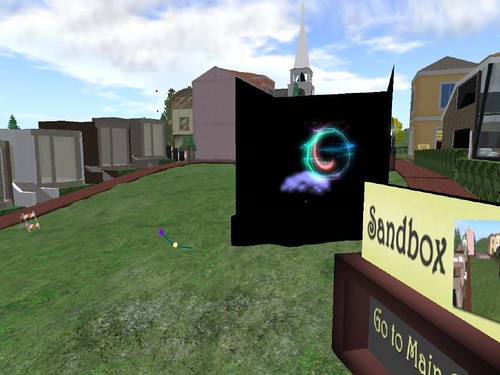
So. Coming out on the other side of my part in this experience, here are some things I think I’ve learned:
– Facilitating a MOOC or even just a small part of one took an enormous investment of time. Ultimately, I couldn’t sustain it at this particular time in my life (crazy busy time at work, very ill family member requiring lots of care, up to my eyeballs in other volunteer projects/efforts). If I had more _time_, however, the mechanisms I used to communicate, get information, and share information, seemed to work pretty darn well for me on my side of the facilitation equation. The googledoc sign up form worked perfectly, the googlegroup invitations were kind of a pain, but once it got going, it worked with no additional tinkering. It is definitely possible to organize larger-scale coordination using free or nearly free web-based tools with a moderate level of tech savvy-ness. It wasn’t the technology implementation that required so much time, but rather the _social_ investment required. I could have increased or sustained more participation, I think, if I had spent more time poking, prodding, emailing, twittering, meeting, asking for help, teaching.
– Wikis, in this experience, and with other projects I work on, continue to be one of the hardest tools to get people to use. I don’t know why this is, but people who otherwise sign up, contribute, join.. they really fall off the wiki wagon quickly. Maybe it’s because I don’t know how to facilitate wiki participation, but I must be missing a really big clue bus on this one, cause I’ve tried everything, and participation on wikis (vs blogs, email lists, even SL itself!) is always lowest.
– Virtual worlds platforms offer two really key affordances to education – 1) the sense of co-presence that enriches synchronous interactions (the sensation that you are really “there” and the other people you’re with are also really “there” and you are all “there” together) and 2) the ability to model, create, simulate, build, share, and collaborate on projects, environments, symbols, data visualization, and other elements that make up the shared environment. In my judgment, except for in the beginning, and even then by a smaller number of participants than I anticipated (only 14 at the height of it), the Connectivism Cohort in Second Life failed to really leverage either. That isn’t to say that those who did participate didn’t get some value out of it, but out of 133 people who originally signed up, I would guess that maybe 20-some people out of the SL Cohort got _some_ substantial value out of their participation (either talking with other class members, or creating something in the space, or learning more about Second Life/virtual worlds).
We simply didn’t have enough participation with enough skilled SL content creators to really explore the medium together in a substantive way, particularly in how a virtual world platform could be used most effectively for _this specific course_. I imagined people collaboratively building together, modeling things we read about or saw in the course content in a 3D form, exploring how concepts might be best represented in 3D versus text, video, image, or 2D. Except with a few minor exceptions, that just didn’t happen. We were more successful in leveraging affordance #1 – I don’t think I am the only one who came away from our synchronous discussions feeling that it had been a very valuable way to spend my time, and that I learned a lot from them – but these remained very small discussions, usually with between 3 – 6 participants.
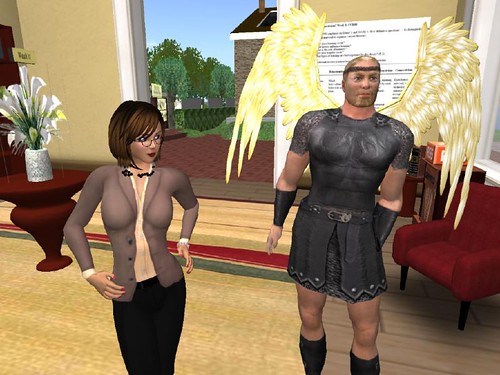
As I said, I think I made some mistakes along the way, in how I framed the cohort, or implemented the various technologies I used. For example, we scheduled the synchronous meetings at several different times to accommodate different time zones, but I think having many different meeting times just diluted the initial momentum and fractured what could have been a stronger, more connected group. Now I’m thinking, if you’re going to commit to the synchronous participation of using a virtual world, then you have to really commit and pick a day and a time and stick with it – unless you have a much larger starting group, more passionate participants, or more people to facilitate the meetings. It seemed like as soon as I stopped being able to make the synchronous meetings, everyone stopped going, even though I had hoped people would just continue on without me, as I’d tried to “crowd source” all the tools needed to do so.
Or perhaps I incorporated _too many_ technologies in trying to empower the crowd. Maybe if I’d just had people sign up for the cohort and then invited them to the group in Second Life and done ALL of the communication through Second Life, maybe more people would have participated… I’m skeptical, though, since SL’s built in communication tools are suboptimal and often don’t work. I dunno.
I’m not entirely sure what all I could or should have done differently, and I do regret “falling off the wagon” – but I don’t regret for one second any of the time I spent on this endeavor. I feel like I got quite a lot out of the experience, and I hope that at least some of what I contributed made the experience better for others taking the class. It was an active, engaging learning experience for me, and I think I will continue to ponder over and learn about connectivism and connective knowledge well into the future, helped by the multitude of resources created by others and shared with me.
So, in conclusion, my thanks to everyone who participated, helped, encouraged, or otherwise took part. My apologies to anyone I let down by not being there enough. I hope this information is helpful to you in some way, even if the rest of it was not. And mega-great thanks to George Siemens and Stephen Downes, who did their own part to encourage me and the SL Cohort, and who gave us all the opportunity to learn together through the Connectivism & Connective Knowledge course. It was one of the singularly most interesting classes I’ve ever taken and I hope I’ll get a pass. =)
Tags: CCK08, CCK08SL, Chilbo, Connectivism, georgesiemens, Second Life, Stephen Downes
![Reblog this post [with Zemanta]](http://img.zemanta.com/reblog_c.png?x-id=030830c1-c72c-4e14-bd7b-81c98a6b96d5)
Hey Fleep
I think I can speak for everyone officially in the SL Cohort in saying you more than participated in #CCK08 you provided examples of the points we discussed in a way that engaged and educated us. Having the metaphor of the reading room helped me overcome being overwhelmed by the material and, as the course material suggests, connecting with you over the material allowed us to make other connections to more knowledge and each other. If not for you my avatar would be standing on some poor avatar’s head as I try to figure out how to create a square. In other words, you were a facilitator/instructor to most of us. I hope we will stay in touch at some level. I continue to grow from your expertise. Stop me before I rez again. 🙂
I suspect a lot of people had doubts about their ability to commit time. I think it’s natural to over-estimate on this and not factor in contingencies. That said, I really want to return to the artefacts of CCK08 at some stage to mull them over further. I’m struggling for a metaphor here but even though I also fell off the wagon, I’m maybe hoping to pick it up again on its return trip.
As an SLer outside the cohort, I was/am very impressed with the Connectivism village. The combination of personal space with open space at the center was perfect, in my opinion. The reading room (although I didn’t actually read anything) and the open plaza were very inviting.
SL can be a fairly intimidating platform for someone coming for the first time with no prior 3D experience, I think. As you point out, this project took a lot of your time, and I can imagine someone who signed up and logged on a few times deciding it would take too much of their time just to get comfortable with the SL basics to be of value to them.
And, once again, getting a glimpse of all the ‘behind the scenes’ work you do I am left thinking, “She’s gotta be at least three people, one person can’t do all that stuff”.
I think I read somewhere regarding what makes a good website – if it takes more than two or three clicks to get the viewer where they want to go, you’ll probably lose them. I think the principle applies to wikis and SL. It takes several clicks to participate in wikis and an untold number of ‘clicks’ to do anything at all in SL. That’s time and I think everyone takes that into account, “How much time do I have for this? Is there a faster way that I am familiar with?”
Blog comments are easy. A couple of clicks and I am done. One click and I can come back and see if there is a conversation going on, even if it is asynchronous, there still can be a flow to blog comments just like forum posts – a format I am more familiar with.
Thanks for this article. This is a part of the course I didn’t really get to explore and I really appreciate the summary telling m what happened over here.
[…] times a little too much, so I feel it is time to reflect on the course and hopefully myself.” Fleep posted a delightful item at the end of the week with a memorable first paragraph “Between the […]
[…] others, throughout this presentation and even in another (virtual) world, Second Life. Thanks to Fleep Tuque, another “tie” which I hope strengthens, who I came to know through this course, […]
Fleep,
I cannot thank you enough for all your work and the opportunity you’ve provided all of us to interact and connect. I was a regular at the weekly Tuesday meetings and although I’ve missed your presence, I’ve met other intelligent and articulate people with whom I have had great conversations on what learning meant. I’ve enjoyed every single meeting – even the ones where only two of us showed up.
It was a worthwhile experience for me. I will miss my weekly connectivism meetings in SL.
[…] numerous times, but I don’t know the stats or attendance numbers or their recent activity. Fleep Tuque has some thoughts on SL, but doesn’t really provide information on numbers attending and […]
Hi Fleep!
I really appreciate all you have done, I’m sorry I could not take advantage of all of it. During the first weeks when the momentum was high I was so overwhelmed with the information that I kept missing the meetings, by the time I started visiting I met others there just once, the other times there was no one. I didn’t get to meet you in world touch I enjoyed the bike ride. Thanks a lot.
What you mention about wikis happens to me as well, people like to go and move around but only few collaborate.
You are not off the wagon, as you mention, the wagon is still there with all the goodies inside.
I hope to keep in touch with you. Have a nice week. Maru :X
[…] to the Moodle forums and bandwidth in rural NSW did very strange things to Pageflakes and made any Second Life participation impossible. I did not tweet and had minimal input to Facebook. I missed the […]